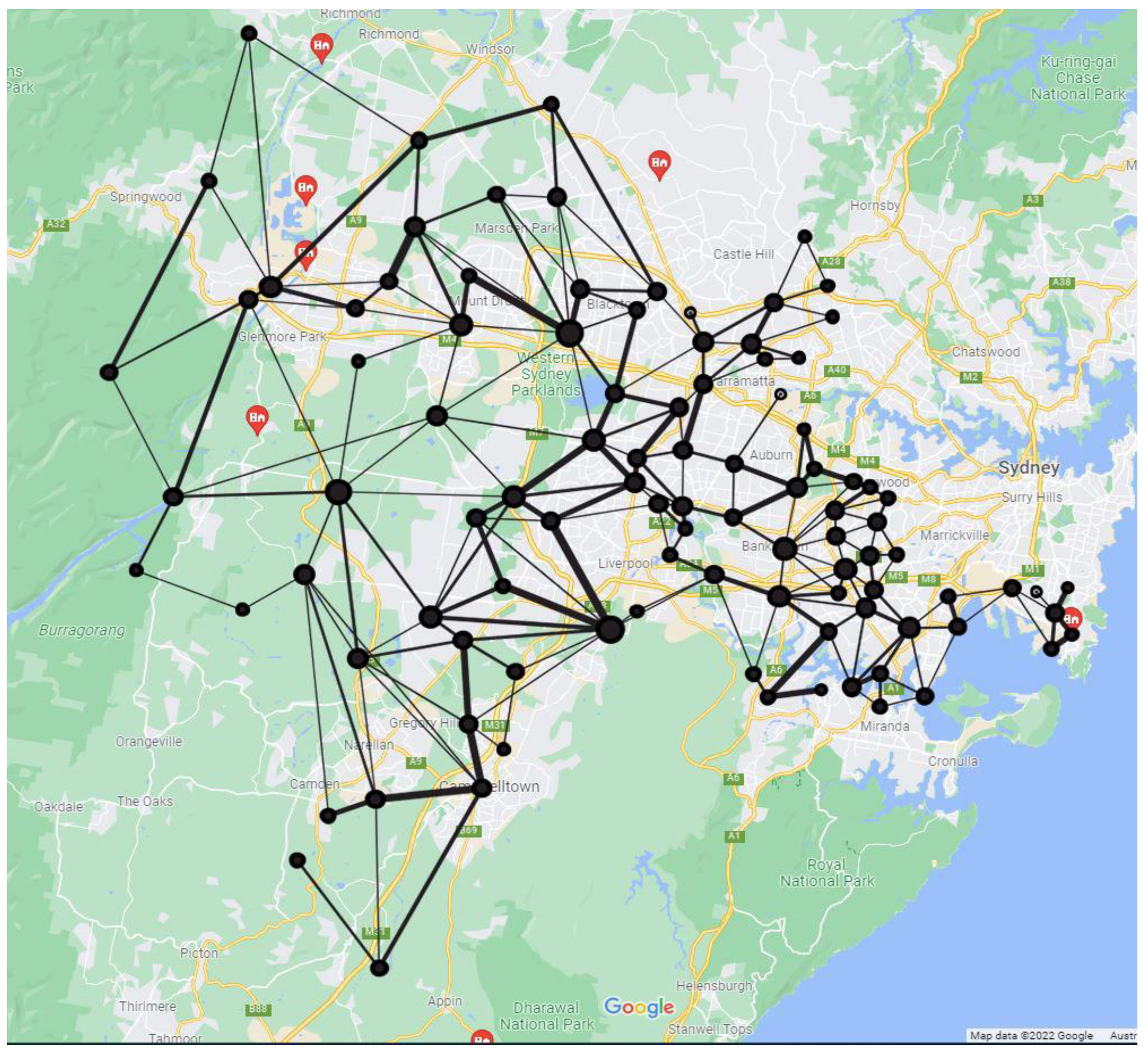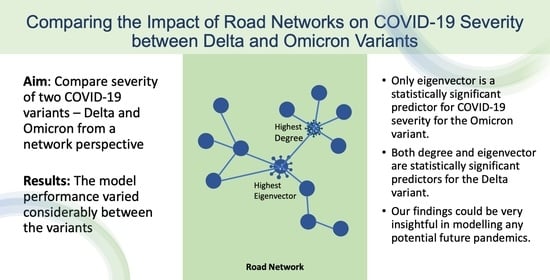Comparing the Impact of Road Networks on COVID-19 Severity between Delta and Omicron Variants: A Study Based on Greater Sydney (Australia) Suburbs
Abstract
:1. Introduction
2. Materials and Methods
2.1. Data
2.2. Construction and Analysis of Suburban Road Networks
2.3. COVID-19 Severity Measure
2.4. Regression Model
2.5. Comparing R-Squared Values
3. Results
4. Discussion
5. Conclusions
Author Contributions
Funding
Informed Consent Statement
Data Availability Statement
Conflicts of Interest
References
- Wang, C.; Han, J. Will the COVID-19 pandemic end with the Delta and Omicron variants? In Environmental Chemistry Letters; Springer: Berlin/Heidelberg, Germany, 2022; pp. 1–11. [Google Scholar]
- Uddin, S.; Khan, A.; Lu, H.; Zhou, F.; Karim, S. Suburban Road Networks to Explore COVID-19 Vulnerability and Severity. Int. J. Environ. Res. Public Health 2022, 19, 2039. [Google Scholar] [CrossRef] [PubMed]
- WHO. Coronavirus (COVID-19) Dashboard. Available online: https://covid19.who.int/ (accessed on 10 March 2022).
- He, S.; Han, J.; Lichtfouse, E. Backward Transmission of COVID-19 from Humans to Animals May Propagate Reinfections and Induce Vaccine Failure; Springer: Berlin/Heidelberg, Germany, 2021; pp. 763–768. [Google Scholar]
- Murray, C.J.L. COVID-19 will continue but the end of the pandemic is near. Lancet 2022, 399, 417–419. [Google Scholar] [CrossRef]
- Yadav, P.D.; Sapkal, G.N.; Ella, R.; Sahay, R.R.; Nyayanit, D.A.; Patil, D.Y.; Deshpande, G.; Shete, A.M.; Gupta, N.; Mohan, V.K.; et al. Neutralization of Beta and Delta variant with sera of COVID-19 recovered cases and vaccinees of inactivated COVID-19 vaccine BBV152/Covaxin. J. Travel Med. 2021, 28, taab104. [Google Scholar] [CrossRef] [PubMed]
- Zhang, M.; Xiao, J.; Deng, A.; Zhang, Y.; Zhuang, Y.; Hu, T.; Li, J.; Tu, H.; Li, B.; Zhou, Y.; et al. Transmission Dynamics of an Outbreak of the COVID-19 Delta Variant B.1.617.2—Guangdong Province, China, May–June 2021. China CDC Wkly. 2021, 3, 584–586. [Google Scholar] [CrossRef]
- Stowe, J.; Andrews, N.; Gower, C.; Gallagher, E.; Utsi, L.; Simmons, R.; Thelwall, S.; Tessier, E.; Groves, N.; Dabrera, G.; et al. Effectiveness of COVID-19 Vaccines against Hospital Admission with the Delta (B.1.617.2) Variant. Available online: https://go.nature.com/3gnqwxr (accessed on 10 March 2022).
- Puhach, O.; Adea, K.; Hulo, N.; Sattonnet-Roche, P.; Genecand, C.; Iten, A.; Bausch, F.J.; Kaiser, L.; Vetter, P.; Eckerle, I.; et al. Infectious viral load in unvaccinated and vaccinated patients infected with SARS-CoV-2 WT, Delta and Omicron. medRxiv 2022. [Google Scholar] [CrossRef]
- Li, B.; Deng, A.; Li, K.; Hu, Y.; Li, Z.; Shi, Y.; Xiong, Q.; Liu, Z.; Guo, Q.; Zou, L.; et al. Viral infection and transmission in a large, well-traced outbreak caused by the SARS-CoV-2 Delta variant. Nat. Commun. 2022, 13, 460. [Google Scholar] [CrossRef] [PubMed]
- Bjorkman, K.K.; Saldi, T.K.; Lasda, E.; Bauer, L.C.; Kovarik, J.; Gonzales, P.K.; Fink, M.R.; Tat, K.L.; Hager, C.R.; Davis, J.C.; et al. Higher viral load drives infrequent severe acute respiratory syndrome coronavirus 2 transmission between asymptomatic residence hall roommates. J. Infect. Dis. 2021, 224, 1316–1324. [Google Scholar] [CrossRef] [PubMed]
- Chen, J.; Wang, R.; Gilby, N.B.; Wei, G.W. Omicron variant (B.1.1.529): Infectivity, vaccine breakthrough, and antibody resistance. J. Chem. Inf. Model. 2022, 62, 412–422. [Google Scholar] [CrossRef] [PubMed]
- Chen, J.; Wang, R.; Wang, M.; Wei, G.W. Mutations strengthened SARS-CoV-2 infectivity. J. Mol. Biol. 2020, 432, 5212–5226. [Google Scholar] [CrossRef] [PubMed]
- Dupont, L.; Snell, L.B.; Graham, C.; Seow, J.; Merrick, B.; Lechmere, T.; Maguire, T.J.; Hallett, S.R.; Pickering, S.; Charalampous, T.; et al. Neutralizing antibody activity in convalescent sera from infection in humans with SARS-CoV-2 and variants of concern. Nat. Microbiol. 2021, 6, 1433–1442. [Google Scholar] [CrossRef] [PubMed]
- Sarkodie, A.S.; Owusu, P.A. Impact of meteorological factors on COVID-19 pandemic: Evidence from top 20 countries with confirmed cases. Environ. Res. 2020, 191, 110101. [Google Scholar] [CrossRef] [PubMed]
- Xu, R.; Rahmandad, H.; Gupta, M.; DiGennaro, C.; Ghaffarzadegan, N.; Amini, H.; Jalali, M.S. The modest impact of weather and air pollution on COVID-19 transmission. Lancet Planet. Health 2020, 5, e671–e680. [Google Scholar] [CrossRef]
- Census QuickStats. Australian Bureau of Statistics: 2016 Census QuickStats. 2021. Available online: https://quickstats.censusdata.abs.gov.au/census_services/getproduct/census/2016/quickstat/POA2190?opendocument (accessed on 10 March 2022).
- Health & Wellbeing. NSW Launches Mandatory RAT Reporting System with $1000 Fines if People Don’t Use It. 2022. Available online: https://7news.com.au/lifestyle/health-wellbeing/how-to-report-positive-rat-results-service-nsw-launches-mandatory-system-for-rapid-antigen-tests-c-5273283 (accessed on 10 March 2022).
- The Straits Times. Omicron Now 90 Per Cent of Cases in Australian State, Says Health Chief. 2022. Available online: https://www.straitstimes.com/asia/australianz/omicron-now-90-per-cent-of-cases-in-australian-state-says-health-chief (accessed on 10 March 2022).
- Wasserman, S.; Faust, K. Social Network Analysis: Methods and Applications; Cambridge University Press: New York, NY, USA, 1994; Volume 8. [Google Scholar]
- Olkin, I.; Finn, J.D. Correlations redux. Psychol. Bull. 1995, 118, 155–164. [Google Scholar] [CrossRef]
- Pedregosa, F.; Varoquaux, G.; Gramfort, A.; Michel, V.; Thirion, B.; Grisel, O.; Blondel, M.; Prettenhofer, P.; Weiss, R.; Dubourg, V.; et al. Scikit-learn: Machine learning in Python. J. Mach. Learn. Res. 2011, 12, 2825–2830. [Google Scholar]
- Ito, K.; Piantham, C.; Nishiura, H. Relative instantaneous reproduction number of Omicron SARS-CoV-2 variant with respect to the Delta variant in Denmark. J. Med. Virol. 2021, 94, 2265–2268. [Google Scholar] [CrossRef] [PubMed]



| Measurement | Definition |
|---|---|
| Degree centrality [20] | It indicates the number of edges that are incident to a node. Suburbs with a high degree have more connections to other suburbs and vice versa. |
| Closeness centrality [20] | It represents the inverse of the geodesic (or shortest) paths between a node and every other node in the network. This measure shows the ease of travelling between suburbs. Suburbs with a high closeness can have faster and easier access to adjacent suburbs. |
| Betweenness centrality [20] | It represents the number of other nodes that have to travel through a certain node in order to obtain their shortest path. Suburbs with a high betweenness centrality are in the shortest path of many other pairs of suburbs. |
| Eigenvector centrality [20] | It specifies the degree to which a node is linked to other significant nodes. A high eigenvector centrality for a node means that it is connected to many other nodes that also have a high score. |
| Core–periphery structure [20] | A coreness score is assigned to each node in the network. A node that is closely linked to other network nodes has a higher coreness score. |
| Delta Variant (from [15]) | Omicron Variant (This Study) | |||||
|---|---|---|---|---|---|---|
| Coefficient | t-Value | p-Value | Coefficient | t-Value | p-Value | |
| Constant | −80.131 | −0.970 | 0.334 | 6.979 | 8.50 | 0.000 |
| Coreness | −0.098 | 0.000 | 1.000 | −4.548 | −1.014 | 0.313 |
| Degree | 1.46 × 105 | 7.342 | 0.000 | 311.898 | 1.575 | 0.118 |
| Closeness | −5.25 × 104 | −0.452 | 0.652 | −968.561 | −0.840 | 0.402 |
| Betweenness | −1423.047 | −0.819 | 0.415 | −20.138 | −1.165 | 0.246 |
| Eigenvector | −1379.437 | −3.944 | 0.000 | −7.013 | −2.017 | 0.046 |
| k | n | 95% CI | Sig. | ||||
|---|---|---|---|---|---|---|---|
| Multiple linear regression | |||||||
| 0.358 | 5 | 130 | 0.0040 | 0.071 | 0.318 ± 0.142 | ≤0.05 | |
| 0.040 | 5 | 130 | 0.0010 | ||||
| Random forest regression | |||||||
| 0.915 | 5 | 130 | 0.0002 | 0.065 | 0.525 ± 0.130 | ≤0.05 | |
| 0.363 | 5 | 130 | 0.0040 | ||||
Publisher’s Note: MDPI stays neutral with regard to jurisdictional claims in published maps and institutional affiliations. |
© 2022 by the authors. Licensee MDPI, Basel, Switzerland. This article is an open access article distributed under the terms and conditions of the Creative Commons Attribution (CC BY) license (https://creativecommons.org/licenses/by/4.0/).
Share and Cite
Uddin, S.; Lu, H.; Khan, A.; Karim, S.; Zhou, F. Comparing the Impact of Road Networks on COVID-19 Severity between Delta and Omicron Variants: A Study Based on Greater Sydney (Australia) Suburbs. Int. J. Environ. Res. Public Health 2022, 19, 6551. https://doi.org/10.3390/ijerph19116551
Uddin S, Lu H, Khan A, Karim S, Zhou F. Comparing the Impact of Road Networks on COVID-19 Severity between Delta and Omicron Variants: A Study Based on Greater Sydney (Australia) Suburbs. International Journal of Environmental Research and Public Health. 2022; 19(11):6551. https://doi.org/10.3390/ijerph19116551
Chicago/Turabian StyleUddin, Shahadat, Haohui Lu, Arif Khan, Shakir Karim, and Fangyu Zhou. 2022. "Comparing the Impact of Road Networks on COVID-19 Severity between Delta and Omicron Variants: A Study Based on Greater Sydney (Australia) Suburbs" International Journal of Environmental Research and Public Health 19, no. 11: 6551. https://doi.org/10.3390/ijerph19116551
APA StyleUddin, S., Lu, H., Khan, A., Karim, S., & Zhou, F. (2022). Comparing the Impact of Road Networks on COVID-19 Severity between Delta and Omicron Variants: A Study Based on Greater Sydney (Australia) Suburbs. International Journal of Environmental Research and Public Health, 19(11), 6551. https://doi.org/10.3390/ijerph19116551









